Abstract
China is a country with abundant karst landscapes, but research on cave biodiversity is still limited. Currently, only Ganxiao Dong, located in Huanjiang, Guangxi, has been reported as a hotspot for cave biodiversity. Many of the world’s most troglomorphic species in the major groups of cave animals have been recently discovered in China, making the existence of many more hotspots in the country likely. Feihu Dong, one of these potential hotspot caves, has been systematically investigated to complement a preliminary species list of 1995, leading to the discovery of 62 species of animals from the cave. Among them, 27 are considered troglobionts or stygobionts, 26 are considered troglophiles or stygophiles, and nine are classified as trogloxenes or stygoxenes. Research on the cave biodiversity of Feihu Dong has demonstrated that it currently holds the highest number of known cave animal species in China. Among the most remarkable features of this fauna is the co-occurrence of five species of cave-obligate beetles, all modified for cave life. The biological survey was limited to a small part of the cave. Several habitats (like guano) have not been investigated so far, and several important cave groups have been insufficiently or not sampled (like Ostracoda). Meanwhile, the system increases in length with each new caving expedition. Further discoveries of cave organisms in Feihu Dong are therefore expected. As Feihu Dong and Ganxiao Dong are the only caves in China that have been extensively studied for a large range of organisms, and as they are located in karstic areas that are similar in richness to other regions of southern China, it can be confidently assumed that several other caves of high biodiversity will be discovered in the coming years.
Keywords:
South China Karst; Hunan; Wulongshan; cave fauna; stygobionts; troglobionts; diversity; checklist; conservation 1. Introduction
China has the largest karst area in the world, covering 3.4 million km2 of soluble rock, including an exposed carbonate rock area of 910,000 km2 [1,2,3]. The South China Karst, one of the world’s largest and most geomorphologically diverse wet tropical-subtropical karst landscapes, stretches from the Qinling Mountains in the north to the Guangxi Basin in the south and from the Hengduan Mountains in the west to the Luoxiao Mountains in the east. This karst crosses the three-step terrain in China from west to east, with an elevation of 110–2100 m and an area of 550,000 km2 [4]. It contains seven exceptional karst landscape clusters that have been designated World Heritage Sites [5].
China not only presents stunning karst landforms but also abundant caves and an exceptional cave biodiversity [6]. It is estimated that there are more than 500,000 caves in China [2]. Currently, the longest explored cave system is Shuanghe Dong in Suiyang County, Guizhou Province, with a reported length of 257.4 km in 2021 [7], which has since been extended to 400.8 km with connected caves increasing from 64 to 105 (Qian Z., pers. comm.). The cave with the largest chamber volume is Miaoting, located in Getuhe, Guizhou Province, with a volume of 10.78 million cubic meters [8]. China is also home to many beautiful and huge caves and tiankengs (the term for giant dolines), such as Zhijin Dong in Guizhou, Shui Dong of Benxi, Liaoning, Shihua Dong in Beijing, or the tiankengs of Dashiwei in Guangxi and Xiaozhai in Chongqing [9,10].
In recent years, the descriptions of subterranean species new to science has considerably increased [11,12,13,14,15,16,17]. To date, only Ganxiao Dong, situated at the junction of the Mulun Karst in Guangxi and the Maolan Karst in Guizhou, has been reported as a regional hotspot of cave biodiversity, with 26 species of cave invertebrates reported, including 20 species of troglobionts and six species of troglophiles [18]. However, our investigation indicates that numerous other areas in China also have a high number of cave species, such as Huoyan Karst in northwestern most Hunan, Hanzhong Karst in southern Shaanxi, Du’an Karst in Guangxi, and Wulong Karst in Chongqing, among others [19].
Wulongshan National Geopark is located in Longshan County, Xiangxi Tujia and Miao Autonomous Prefecture, Hunan Province, at the junction of Hunan and Hubei Provinces and Chongqing Municipality. The most famous scenic spots in Wulongshan Park are in the Huoyan Karst, where 212 caves have been recorded [20], including Feihu Dong, Wulong Dong, Shihua Dong, Feng Dong, and Lianyu Dong. Among them, Feihu Dong is the most spectacular. From 1993 to 2002, cave explorers and biologists from the Sino-French joint expedition team and from other countries such as Slovenia, Belgium, and Japan came to Feihu Dong for several scientific expeditions [21,22,23]. The cave is today nearly 20 km long and has not been fully explored (Figure 1). Underground rivers, lakes, boulders, and side passages have been reported in Feihu Dong [22,24]. The cave is inhabited by abundant and diversified subterranean fauna that includes a number of troglobiotic/stygobiotic and endemic species [25,26,27], such as Triplophysa xiangxiensis (Yang, Yuan and Liao, 1986); Caridina longshan Cai and Ng, 2018; Toshiaphaenops ovicollis Ueno, 1999; Angustopila huoyani Jochum, Slapnik and Páll-Gergely, 2014 [23,28,29,30].

Figure 1.
Overview of the geographical location of Feihu Dong and other caves in Huoyan Karst: base map and data from SHAG Caving Association, except the location data of three potential shafts from the Xiangxi Cave Expedition.
After the joint expeditions of 1993–2002, there has not been any further systematic cave survey or biological sampling in Feihu Dong. Recently, in February 2023, an exploration project of Feihu Dong was resumed under the leadership of the Caves Committee of the Geological Society of China. The project was mainly executed by the Xiangxi Cave Exploration Team, which used paperless cave surveying and 3D laser scanning technology to re-explore and investigate Feihu Dong. In April 2023, the team have completed the re-survey of approximately 4 km from the main entrance and the newly discovered approximately 2.2 km of cave passage during the last three explorations (Wang Y., pers. comm.). At the same time, the South China Agricultural University (SCAU) biocaving team conducted a week-long systematic survey of cave fauna in Feihu Dong in February 2023 and discovered additional cave animals.
The purpose of this study is to provide an updated list of animals living in Feihu Dong, to draw attention to the scientific importance of these species and their fascinating habitats, and to contribute to the subterranean biodiversity in China.
2. Materials and Methods
2.1. Research Site
Feihu Dong (飞虎洞, “Flying Tiger Cave” in Chinese) (Figure 1) is located in the Grand Canyon of Wulong Mountain, in Longshan County, Xiangxi Tujia and Miao Autonomous Prefecture, northeastern Hunan Province.
Feihu Dong is a complex cave system (Figure 2) with three entrances (Figure 3 and Figure 4A–D), one of which is a −320 m deep shaft (Figure 3), long galleries (Figure 4E) adorned with speleothems (Figure 4F,G), large chambers, subterranean lakes and rivers. The length of the explored and surveyed cave passages is about 20 km in total. The main entrance of the cave, Feihu Dong (coordinates: 29°12′28.4″ N 109°18′16.4″ E), is at an altitude of around 360 m a.s.l. A three-kilometer-long gallery from the entrance is connected to a large chamber of 26,400 m2 in surface. A large shaft named “Gouffre Super Tong”, with a waterfall inside, opens on the karst surface and leads 320 m deeper to the northern part of this chamber (Figure 3). In addition, three potential shafts that may be connected to Feihu Dong are marked on the map (Figure 1) (Wang Y., pers. comm.). Some location names within Feihu Dong are translated between French, English, and Chinese in Table 1.
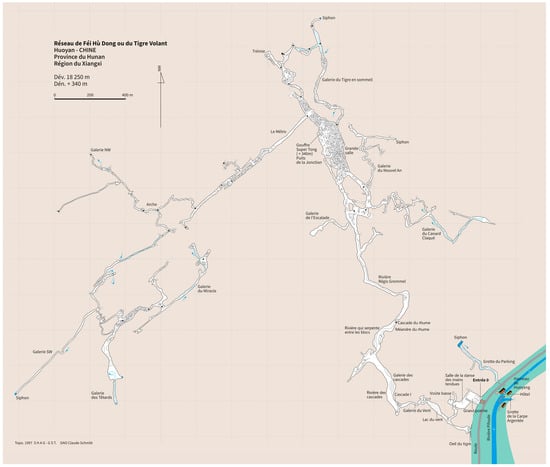
Figure 2.
Cave map of Feihu Dong: “Topographie de la Grotte du Tigre Volant (Feihu Dong)” drawn by SHAG Caving Association.
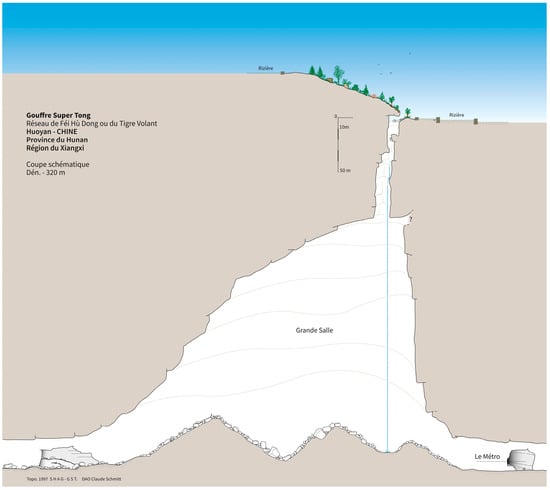
Figure 3.
Cave map of the shaft “Gouffre Super Tong”, explored and mapped by the SHAG Caving Association.
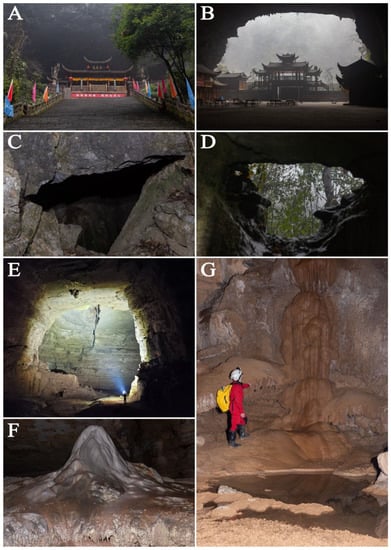
Figure 4.
Entrances and habitats of Feihu Dong: (A,B) the main entrance, “Large Porch Entrance”; (C,D) the entrance of “Tiger Eye”; (E) Waterfall Gallery; (F,G) speleothems.

Table 1.
Names of some locations in Feihu Dong.
2.2. Sampling
To update the list of cave fauna in Feihu Dong, we reviewed the available literature and conducted explorations from February to April 2023, led by the South China Agricultural University Biocaving Team and Xiangxi Cave Expedition, to upgrade the first biological exploration carried out in August 1995 by Louis Deharveng and Anne Bedos from the Muséum National d’Histoire Naturelle (MNHN Paris) during the Xiangxi 95 expedition. We sampled different habitats within the cave, and we used a combination of direct sampling, baited traps, and litter extraction methods to collect small invertebrates. Direct sampling was performed by hand or using an aspirator, and baited traps were set up using bananas and fish gut as attractants for terrestrial and aquatic animals. Litter extraction was performed using a sifter to separate soil-dwelling animals from organic matter. All specimens were kept in 75% ethanol for morphological studies and identification or 95% ethanol for DNA sequencing. Photos of the cave animals were taken by a Canon EOS 6D camera (Tokyo, Japan) with a Sigma 50 mm F2.8 EX DG Macro lens (Kanagawa, Japan) and an adapted Meike MK-14 ext E-TTL macro flash (Hongkong, China). They were then processed using Photoshop CC 2019 (San Jose, CA, USA).
2.3. Terminology
Ecological classification of cave animals and troglomorphy are defined as in Huang et al., 2021 [18].
3. Results
3.1. Fauna Composition of Feihu Dong
In total, 62 species of animals have been discovered in Feihu Dong. In the current state of our knowledge, 27 of these species are considered troglobionts (23 species) or stygobionts (four species) taxa, 26 as troglophiles (24 species) or stygophiles (two species), and the remaining nine as trogloxenes (six species) or stygoxenes (three species) (Table 2).

Table 2.
Species list of cave animals found in cave Feihu Dong. Column status: Tb = troglobiont; Tp = troglophile; Tx = trogloxene; Sb = stygobiont; Sp = stygophile; Sx = stygoxene; * = known endemic of the Huoyan karst or of Feihu Dong; ? = uncertain ecological status or species under study; SCAU = South China Agricultural University.
3.2. Notes on Animals Found in Feihu Dong
Firstly, it has to be stressed that the taxonomic coverage of our species list is biased. The group that contributes the most to aquatic diversity, Microcrustacea, has not been sampled.
Aside from this gap, a total of 62 animal species occurs in Feihu Dong, and Insecta are the most abundant group with 22 recorded representatives. Many of them are classified as troglobionts as their occurrence is limited to cave habitats, and they frequently exhibit troglomorphic characters. The major and interesting groups are listed and discussed below.
3.2.1. Mollusca
Mollusca in Feihu Dong comprise four species. Unidentified Subulinidae (Figure 5A), a very frequent troglophile of tropical caves, and Helixarionoidea (Figure 5B) shells were located inside the Tiger Eye. Synprosphyma cf. lyra (Figure 5C), found in the Low Vault and Flu Waterfall, appears to be the most common species. This species may enter the cave through the underground water system since the specimens near the waterfall are buried in litter, which arrives from outside. Another minute gastropod, Angustopila huoyani, discovered in the entrance corridor [30], was not encountered during the 2023 survey.
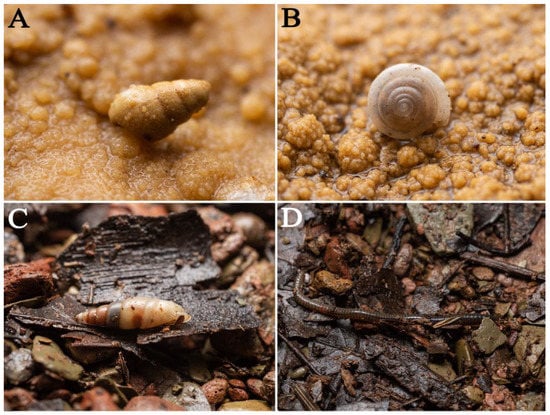
Figure 5.
Animals found in Feihu Dong: (A) Subulinidae sp.; (B) Helixarionoidea sp.; (C) Synprosphyma cf. lyra (Gredler,1887); (D) Oligochaeta sp.
3.2.2. Arachnida
Six species of spiders are found in various sections of Feihu Dong. Telema wunderlichi (Figure 6A), a Belisana species (Figure 6B), and an Agelenidae species (Figure 6D) were mostly observed in a moist microhabitat in Tiger Eye, hiding under scattered rubble. A Linyphiidae species (Figure 6C) and Papiliocoelotes guitangensis (Figure 6E) were found on the ground of the Low Vault. The unidentified Pholcidae species was collected far inside the cave, after the large chamber; it has extremely long legs and unpigmented, reduced eyes. We can confidently say that Telema wunderlichi is a trogobiont because of its eyelessness. In addition, we assume that Belisana, as well as the unidentified Agelenidae, which have reduced pigmentation in the body and eyes, are also troglobionts. Papiliocoelotes guitangensis, though only known from caves, has no adaptive characters related to cave life [31] and is here assumed to be a troglophile.
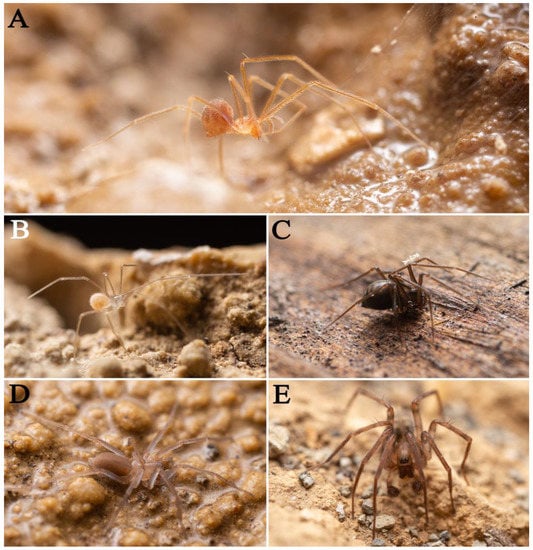
Figure 6.
Animals found in Feihu Dong: (A) Telema wunderlichi Song and Zhu, 1994; (B) Belisana sp.; (C) Linyphiidae sp.; (D) Agelenidae sp.; (E) Papiliocoelotes guitangensis Zhao and Li, 2016.
The Opilionida Schenkeliobunum, probably S. wuxi Lu, Wang and Zhang, 2022 (Figure 7A), discovered in subtropical forest in Chongqing [38], was documented on the ground of Tiger Eye. It is likely a widely distributed species, inhabiting different humid habitats. A single specimen of an unidentified, blind, and highly modified Laniatores was found in the large chamber [26]. It seems to be similar to the cave restricted Opilionida of Southeast Asia, but these usually have eyes.
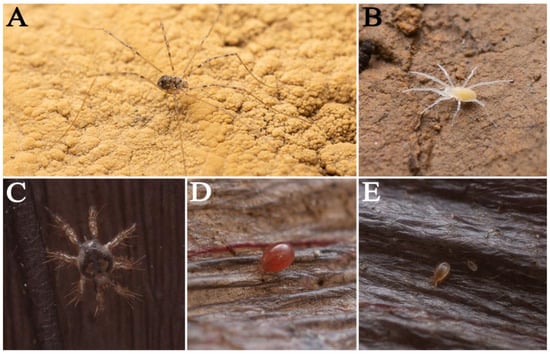
Figure 7.
Animals found in Feihu Dong: (A) Schenkeliobunum cf. wuxi Lu, Wang and Zhang, 2022; (B) Rhagidiidae sp.; (C) Spinturnicidae sp.; (D) Acari sp. 1; (E) Acari sp. 2.
3.2.3. Diplopoda
Millipedes are among the most common large invertebrates in Feihu Dong. Glyphiulus deharvengi (Figure 8A) and Eutrichodesmus sketi (Figure 8B) are widespread in the cave. The presence of these species was expected, as both genera are very frequently found and highly diversified in South China caves [11,14,39]. Eutrichodesmus sketi is eyeless. Glyphiulus deharvengi has eyes but is unpigmented and is likely a troglobiont. An undescribed Epanerchodus species (Figure 8C) has a scattered distribution inside the cave. This Epanerchodus exhibits an unusual morphological polymorphism related to its spatial distribution in the cave (Figure 8C,D). However, the different forms recognized were confirmed to be conspecific according to both genital features and preliminary barcoding results.

Figure 8.
Animals found in Feihu Dong: (A) Glyphiulus deharvengi Golovatch, Geoffroy, Mauriès and Van Den Spiegel, 2007; (B) Eutrichodesmus sketi Golovatch, Geoffroy, Mauriès and Van Den Spiegel, 2015; (C) Epanerchodus sp. from Régis Gremmel River; (D) Epanerchodus sp. from Tiger Eye.
3.2.4. Chilopoda
Chilopoda in Feihu Dong comprise two species, viz. Lithobius (Monotarsobius) sp. (Figure 9A) and a Geophilidae species (Figure 9B). The depigmented Lithobius is probably a troglobiont and was found near the Tiger Eye and at a deeper site, Flu Waterfall. In southern China caves, Lithobiidae are rare, with only two Australobius species reported from Guizhou and Guangxi [19,40]. The Geophilidae species is probably a troglophile, found only near the Tiger Eye.
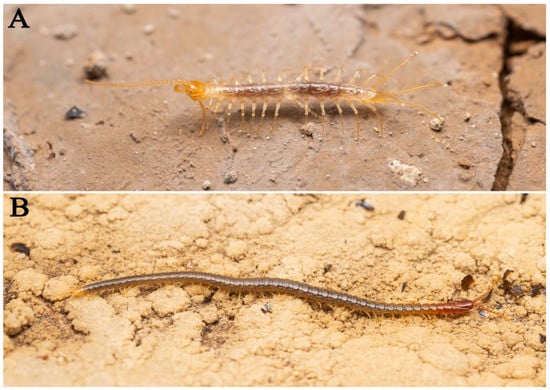
Figure 9.
Animals found in Feihu Dong: (A) Lithobius (Monotarsobius) sp.; (B) Geophilidae sp.
3.2.5. Crustacea
Crustaceans are represented by three moderately troglomorphic species, viz., Caridina longshan (Figure 10A), Gammarus sp. (Figure 10B), and Trogloniscus sp. (Figure 10C). All of them lack either pigment or eyes. Gammarus are common in most of the aquatic microhabitats inside Feihu Dong. Caridina longshan was collected in Flu Meander, and Trogloniscus sp. was collected in the Régis Gremmel River (Figure 4F).
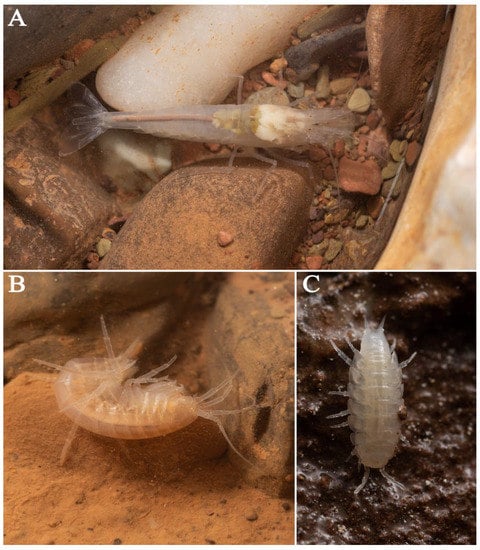
Figure 10.
Animals found in Feihu Dong: (A) Caridina longshan Cai and Ng, 2018; (B) Gammarus sp.; (C) Trogloniscus sp.
In addition, a species of lernaeid copepod had been observed on the blind fish Triplophysa xiangxiensis (Zhou J.J., pers. comm.).
3.2.6. Non-Insect Hexapods
A Campodeidae species (Figure 11A) inhabits the dried and sandy habitats of the Régis Gremmel River. It occurs individually and keeps crawling all the time. The combination of its long antennae, cerci, and large size suggests that the species might be a troglobiont. The knowledge of the eight species of Chinese cave-dwelling Campodeidae was summarized by Sendra et al. in 2021 [41]. Remarkable troglomorphic features are obvious in most species, and the Feihu Dong Campodeidae is another highly troglomorphic species of southern China.
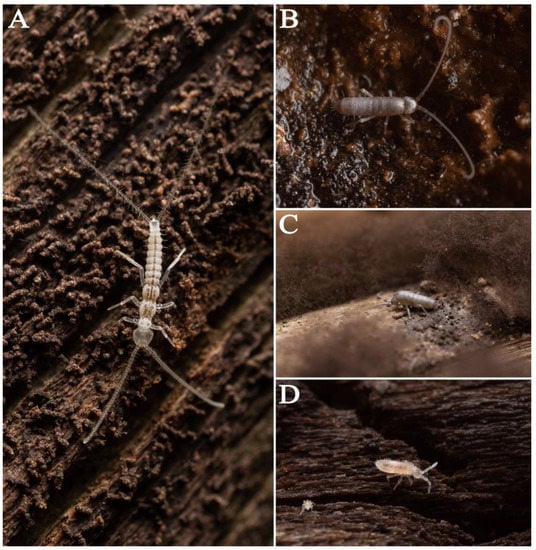
Figure 11.
Animals found in Feihu Dong: (A) Campodeidae sp.; (B,C) Tomocerus sp.; (D) Coecobrya sp.
Springtails were found on decayed wood and leaves that were brought into the cave by the water flow or human activity. We found species of Tomocerus (Figure 11B,C) and Coecobrya (Figure 11D) in several collecting points that were associated with predators, e.g., ground beetles and pselaphine beetles. These two springtail genera are highly diversified in southern China’s caves.
3.2.7. Insecta
- Coleoptera
Nine species of beetles were collected in Feihu Dong, including four Carabidae, three Staphylinidae, one Ptinidae, and one Endomychidae. The troglomorphic carabids Toshiaphaenops ovicollis (Figure 12A), Huoyanodytes tujiaphilus (Figure 12B), Cathaiaphaenops (Cathaiaphaenops) delprati (Figure 12C), and Sinotroglodytes bedosae are widespread in the cave system. During the survey in 2023, the former three species were spotted. In addition, a larva of C. delprati (Figure 12D) was captured among an adult population located in Flu Waterfall. Three elytra of ground beetles were uncovered under the compacted sand on the Régis Gremmel River during our survey, which can be attributed to C. delprati (two pieces) (Figure 12E) and T. ovicollis (one piece) (Figure 12F), respectively. We assume that blind ground beetles are abundant during the rainy season, when strong water flow is carrying lots of resources inside the cave.
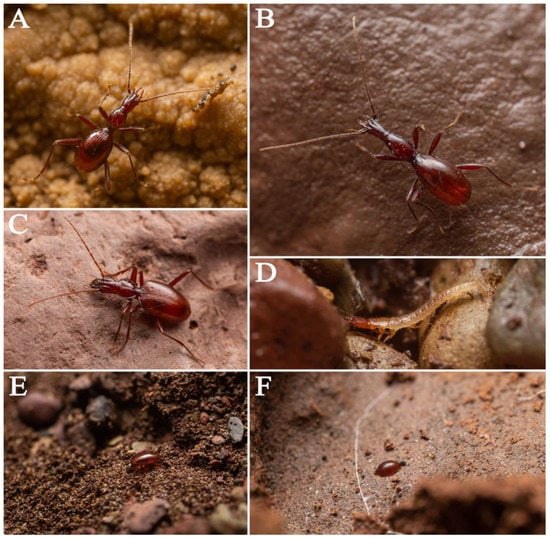
Figure 12.
Animals found in Feihu Dong: (A) Toshiaphaenops ovicollis Ueno, 1999; (B) Huoyanodytes tujiaphilus Tian and Huang, 2016; (C–E) adult, larva, and elytra of Cathaiaphaenops (Cathaiaphaenops) delprati Deuve, 1996; (F) elytra of Toshiaphaenops ovicollis Ueno, 1999.
For staphylinids, the troglomorphic Zopherobatrus tianmingyii (Figure 13A), which is also reported from a limestone cave in Guizhou [42], was found near Tiger Eye, accompanied with a lot of springtails, while a possibly troglophile Nipponobythus (Figure 13B) species was found alone near the Waterfall No. I. The genus Zopherobatrus contains three species, all troglobionts with reduced eyes, previously known from Guizhou, Chongqing, and Sichuan [19]. Quedius feihuensis Smetana, 1999 was collected together with Cathaiaphaenops. In spite of being only known from Feihu Dong, the species has no troglomorphic character and is likely a trogloxene [34].
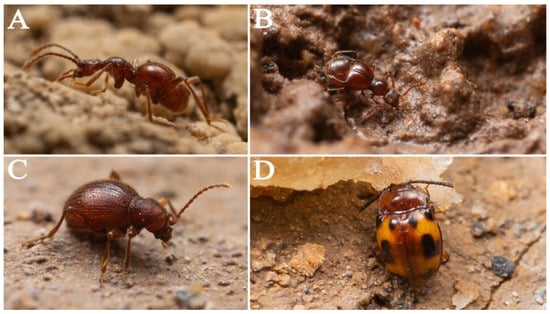
Figure 13.
Animals found in Feihu Dong: (A) Zopherobatrus tianmingyii Yin and Li, 2015; (B) Nipponobythus sp.; (C) Pseudeurostus hilleri (Reitter, 1877); (D) Mycetina sp.
In addition, two other beetles are trogloxenes, viz. Pseudeurostus hilleri (Figure 13C) and a Mycetina species (Figure 13D). They were attracted by baits (banana and fish gut), and we settled in Low Vault.
- Orthoptera
Three species of the family Rhaphidophoridae have been spotted in Feihu Dong. Tachycines (Gymnaeta) solidus (Figure 14B), restricted to the Room of the Dance of Outstretched Hands, is probably a troglophile due to its normal-sized eyes and dark, striped body. Eutachycines crenatus (Figure 14C) occupies a deeper section of the cave, from Tiger Eye to Wind Gallery, including Low Vault. It has a depigmented body, medium-sized eyes, and a strongly crenate abdomen, which demonstrate its link to cavernicolous life. The third species, Tachycines (Gymnaeta) omninocaecus (Figure 14A), was found along the Régis Gremmel River, far distant from the two aforementioned species. Tachycines omninocaecus is a highly troglomorphic cricket on account of its eyelessness and pale body. The degree of troglomorphy seems related to the spatial distribution of this species within the Feihu Dong system when compared to that of the two other cave crickets.
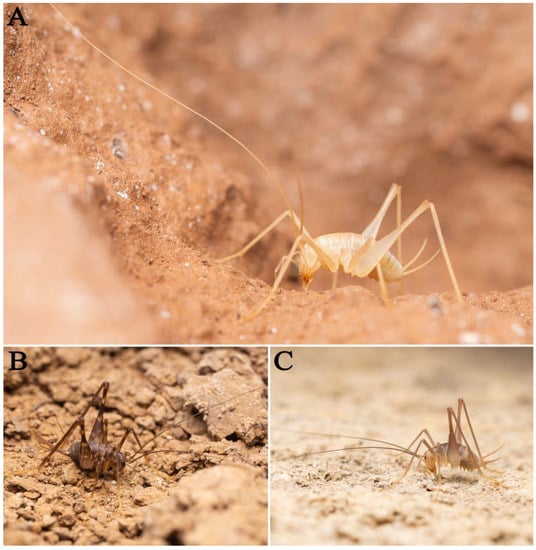
Figure 14.
Animals found in Feihu Dong: (A) Tachycines (Gymnaeta) omninocaecus (Gorochov, Rampini and Di Russo, 2006); (B) Tachycines (Gymnaeta) solidus (Gorochov, Rampini and Di Russo, 2006); (C) Eutachycines crenatus (Gorochov, Rampini and Di Russo, 2006).
- Siphonaptera
A peculiar flea (Figure 15A), which is non-jumpable and belongs to the family Ischnopsyllidae, was observed by the second author (Zhao M.Z.) (Figure 15B). The species has a rather elongated body and legs. Based on our observations, it seems it crawls slowly and uses its forelegs to detect the environment. Congeneric specimens were also obtained from caves in Guizhou Province and convincingly support their parasitism on bats. Further studies regarding its taxonomy and biology are currently being conducted.
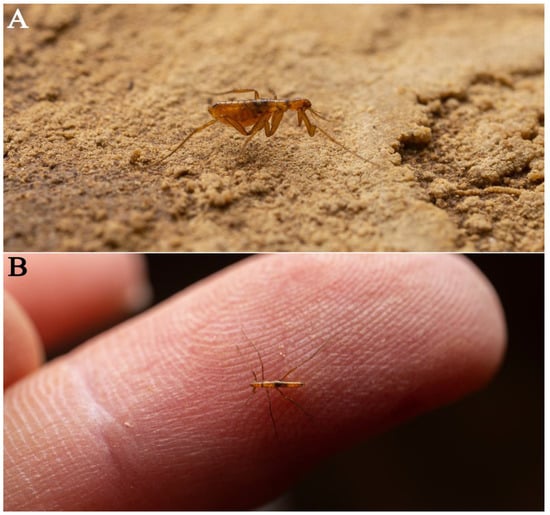
Figure 15.
Animals found in Feihu Dong: (A,B) Ischnopsyllidae sp.
- Aquatic insects
The aquatic insect fauna in Feihu Dong is represented by three species belonging to Odonata, Plecoptera, and Trichoptera. A Sarasaeschna species of the dragonfly family Aeshnidae was found in the Waterfall River. Four final instar (Figure 16A) and one probably penultimate instar (Figure 16B) nymphs were found in the shallow water. Unlike the Sarasaeschna species in Ganxiao Cave [18], troglomorphic characters are absent in the final instar nymph of the species found in Feihu Dong. However, we noticed that the younger nymph has a depigmented body and partially developed eyes. The troglophilic status of this species is under investigation. In addition, two mature Trichoptera larvae (Figure 16C) were hidden under the stones of the Régis Gremmel River. We had also uncovered final stage nymphs (Figure 16D) of a Perlidae (Plecoptera) in shallow water of Flu Meander. The discovery of these aquatic insects inside Feihu Dong reveals the complexity of the subterranean water system. The most likely is that a connection exists between the subterranean water and a sinking stream from the surface that remains to be spotted.
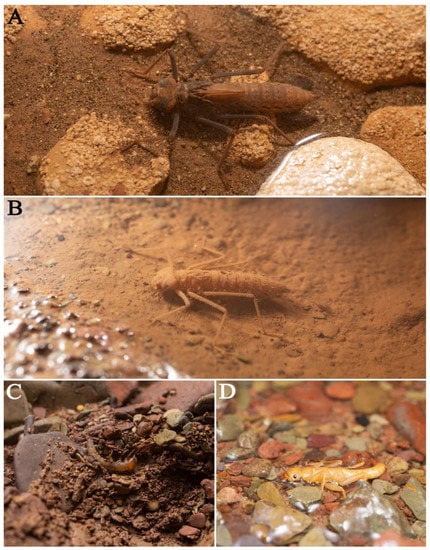
Figure 16.
Animals found in Feihu Dong: (A,B) ultimate and penultimate instar nymphs of Sarasaeschna sp.; (C) Trichoptera sp.; (D) Perlidae sp.
- Other insects
Triphosa species (Figure 17A), one of the common troglophilic moths in China, were frequently seen on the walls from the entrance to deep sections (ca. 0–4 km inside the cave Feihu Dong), sometimes infected by fungi (Figure 17B). Additionally, Tineidae (Lepidoptera) (Figure 17C) and Anisolabididae (Dermaptera) (Figure 17G), as well as Psychodidae (Figure 17D), Culicidae (Figure 17E) and Limoniidae (Figure 17F) (all Diptera), are each represented by one species. Except for the Limoniidae, others are spotted as single individuals. These five species are difficult to assign to an ecological category. However, tineid and psychodid are very often linked to guano in caves, while the three other Diptera belong to families that are among the dominant troglophiles of temperate cave entrances.
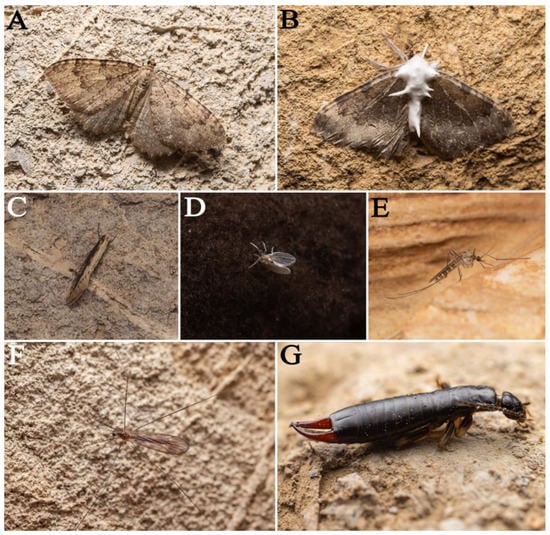
Figure 17.
Animals found in Feihu Dong: (A,B) Triphosa sp.; (C) Tineidae sp.; (D) Psychodinae sp.; (E) Culicidae sp.; (F) Limoniidae sp.; (G) Anisolabididae sp.
3.2.8. Vertebrates
Vertebrates encompass two fish, two frogs, and five bats. The only stygobiotic vertebrate is Triplophysa xiangxiensis (Figure 18A), a completely blind fish. The genus comprises 102 species in China, and all the identified cave-dwelling species of the genus were reported from China. More than one fourth of them are typical cavefish, with eyes and pigmentation reduced or completely lost. They are restricted to the karst regions of Yunnan, Hunan, Guizhou, Guangxi, and Chongqing [43,44,45].
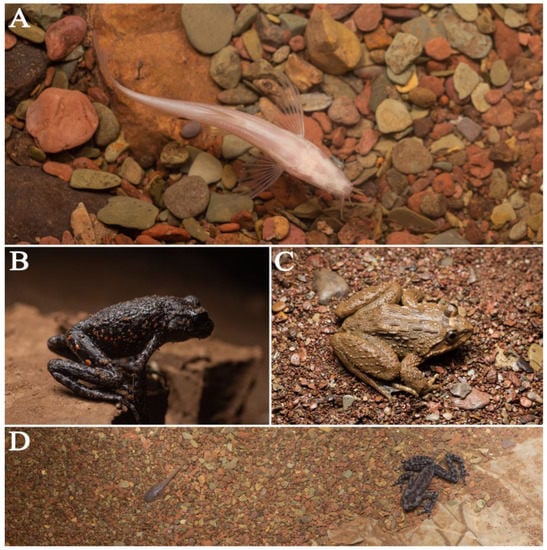
Figure 18.
Animals found in Feihu Dong: (A) Triplophysa xiangxiensis (Yang, Yuan and Liao, 1986); (B) adult Oreolalax rhodostigmatus Hu and Fei, 1979; (C) Rana sp.; (D) larva and adult Oreolalax rhodostigmatus Hu and Fei, 1979.
Triplophysa xiangxiensis coexists with tadpoles of Oreolalax rhodostigmatus (Figure 18B,D), a troglophilic frog, and with the degenerated eyes of the shrimp Caridina longshan. Moreover, two trogloxenes, viz., the frog Rana sp. (Figure 18C) and the fish Misgurnus anguillicaudatus, were discovered accidentally. During winter, bats are scarcely seen along our explored sections inside the cave, yet they accommodate five species (three Rhinolophus and two Myotis) (Figure 19). Due to the roof of the cave being quite high in most sections, we may have missed some hibernating bats. The bats we observed do not form colonies during the winter season. Their guano is rather scattered in the cave, providing an important source of nourishment for cave-dwelling invertebrates.
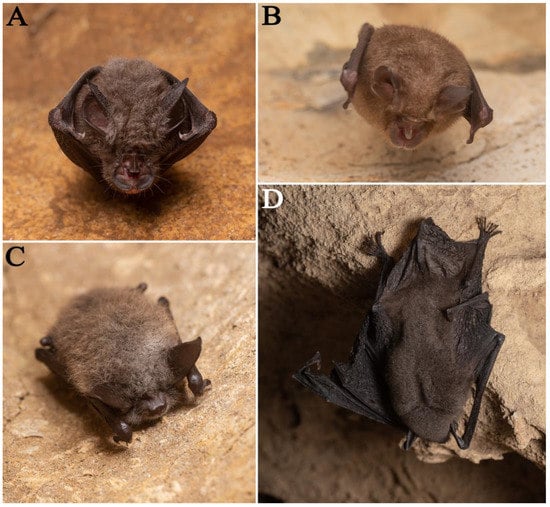
Figure 19.
Animals found in Feihu Dong: (A) Rhinolophus pearsonii Horsfield, 1851; (B) Rhinolophus pusillus Temminck, 1834; (C) Myotis altarium Thomas, 1911; (D) Myotis chinensis (Tomes, 1857).
3.2.9. Other Animals
Besides what we discussed above, the fauna of Feihu Dong also includes a flatworm and an earthworm. The flatworm may be assigned to Dugesia japonica, but the photo is not available [25]. A trogloxene or stygoxene earthworm (Figure 5D) was found in Flu Waterfall, where a lot of organic matter accumulates from outside.
4. Discussion
Explorations into the subterranean biodiversity of Feihu Dong revealed an abundance of cave-dwelling fauna, exceeding initial expectations. Here we discuss the implications of these findings for underscoring the significance of Feihu Dong as a site warranting further research and conservation efforts.
4.1. Biodiversity Features of Feihu Dong
The subterranean ecosystem of Feihu Dong has been found to be highly diverse and unique, with a total of 27 troglobiotic species recognized in this study. This is a significantly higher number compared to other known caves in South China, such as Ganxiao Dong (20 troglobionts) [18]. Among the different taxonomic groups of subterranean fauna, insects were found to be the most diverse, with eight troglobiotic species identified, including five beetles.
Regarding endemism, 15 of the cited species are restricted to the surrounding karst area. All but one of the 13 troglobiotic (11 species) or stygobiotic (two species) species identified at the species level are endemic to Feihu Dong or to the karst area of Huoyan, except Zopherobatrus tianmingyii, which is also reported from Guizhou [42].
The troglobionts (23 species) and stygobionts (four species) found in Feihu Dong represent a diverse range of taxa that have reached different levels of troglomorphy. Though generally less morphologically modified than species of cave communities in southern Guizhou and northern Guangxi, some species of Feihu Dong are highly troglomorphic, such as the blind ground beetle Huoyanodytes tujiaphilus or the blind fish Triplophysa xiangxiensis. Interestingly, several of the large stygobionts Gammarus sp., Caridina longshan, Triplophysa xiangxiensis, and the tadpoles of the frog Oreolalax rhodostigmatus may occur in high numbers (such as G. sp. in Waterfall River) and may even co-occur (such as the tadpoles of O. rhodostigmatus, T. xiangxiensis, and C. longshan in Flu Meander).
4.2. Discussion on Some Animals Found in Cave Feihu Dong
Millipedes are commonly seen in caves, where they typically rest on cave walls or attach themselves to decayed wood. In our 2023 investigations, we did not observe large numbers of millipedes in Feihu Dong. This may be due to a lack of food, as bats are known to hibernate during the winter and water flow is often reduced.
Reduced eyes Caridina (with cornea pigmentation ranging from totally absent to a small black spot) and blind Gammarus are known by many narrowly distributed species from several caves in south China [46,47,48], mostly described in recent years. Their presence in Feihu Dong is in line with this distribution. Trogloniscus sp. belongs to an oligospecific genus of more or less amphibious species known from Guangxi, Guizhou, and Guangdong [19,49]. Its presence in Feihu Dong extends significantly to the north of the distribution of the genus.
Regarding the blind carabid beetle, Cimmeritodes (Cimmeritodes) huangi Deuve, 1996, reported from the cave Baiyan Dong in Huoyan Karst [21]. It is less than 1 km between Baiyan Dong and Feihu Dong in straight-line distance and the beetle is very likely to occur in Feihu Dong.
Some of the unidentified troglobiotic or stygobiotic species may also be endemic to the area, e.g., the springtails Coecobrya sp. and Tomocerus sp., the spiders Belisana sp. and Agelenidae sp., the Chilopoda Lithobius (Monotarsobius) sp., the Gammaridae Gammarus sp., the woodlice Trogloniscus sp., and highlighting the need for further investigation and taxonomic research in this region.
4.3. Threats and Conservation
One of the threats to the biodiversity of Feihu Dong is the potential impact of tourism. With the increasing popularity of the cave as a tourist destination, excessive tourism development and overcrowding have the potential to negatively affect the cave’s ecosystem. It is important to note that the impact of tourism on the cave biodiversity is not yet significant, as its development has been limited to the entrance area, which is, like in all touristic caves, severely disturbed, while kilometers of very large undisturbed galleries exist beyond this area. However, to prevent future negative impacts on biodiversity, it would be useful to maintain the majority of passages, chambers, and cave floors in their original state. For this purpose, several measures could be taken. Firstly, limiting the extent of touristic passages and the number of visitors permitted in the cave at any time. Secondly, monitoring cave biodiversity and conducting regular scientific research as a background to sound conservation measures. Thirdly, encouraging a moderate development that would preserve most cave passages. Fourthly, keep the cave entrance open and not subject to drastic human impacts, to allow the easy passage of bats in and out of the cave. It is less the problem of the entrance itself, which is very large, than of human activity at this entrance, which should remain reasonable in terms of light and noise. It may be beneficial to consider limiting festivals or infrastructural works within the cave from the main entrance to the “Room of the Dance of Outstretched Hands” to further reduce human impact on the cave’s ecosystem. Fifthly, it is crucial to provide adequate protection for the unique and best documented cave species found in Feihu Dong, the blind fish Triplophysa xiangxiensis, which had been assessed for The IUCN Red List of Threatened Species in 1996 and was listed as Vulnerable under criteria D2 [50]. It is also classified as Category II in the list of National Key Protected Wild Animals in China [51]. Moreover, two species of Carabidae of Feihu Dong (Cathaiaphaenops delprati, Huoyanodytes tujiaphilus), which are the best known invertebrates of the cave, have been recently assigned to the IUCN category “Data Deficient” [52,53], highlighting the fact that further investigations on the Feihu Dong invertebrate fauna are needed to understand the magnitude and extent of the local cave biodiversity. The current and fast development of tourism and associated potential disturbance in the area should be carefully followed during the coming years, in completing for aquatic microcrustacea the baseline inventory proposed here, in assessing the vulnerability of the other troglobionts of the cave system, and in using some of them to monitor changes in biodiversity. That would provide the background needed to implement appropriate conservation measures if they become necessary.
4.4. Limitations and Prospects
The subterranean biodiversity of Feihu Dong is far from being fully explored and understood. Although several surveys have been conducted, there are still limitations and prospects that need to be addressed to have a comprehensive understanding of the subterranean biodiversity of Feihu Dong.
One limitation is that the survey area is still relatively limited, and most deeper areas have yet to be explored. Regarding the sampling effort in the aquatic environment, we conducted very few investigations concerned with the baited traps and litter extraction in the water. The aquatic fauna of the Feihu Dong system remains poorly known, and further surveys are needed to fully understand the diversity and ecology of this unique ecosystem. Another gap to fill is that many species have not been identified yet, making their ecological traits difficult to assess. We have not been able to determine the relationship between some of the trogloxenes or stygoxenes and the cave environment, given our poor knowledge of cave fauna in the region. The group to which these species belong has also sometimes been reported from caves. For example, the staphylinid beetle Quedius feihuensis was only found in Feihu Dong and is considered here as a trogloxene based on morphology, but other species of the same genus and of similar morphology are also reported from caves [54,55]. This suggests that it may be benefiting from the cave environment in some way. So, we took into account trogloxenes and stygoxenes in this paper. We also face the challenge of finding taxonomists who can deal with the selected material, which is also a classical issue in countries where cave fauna remains under-investigated. Overcoming these limitations would require more extensive and in-depth surveys across the Feihu Dong system, and in the surrounding karst.
There is therefore a significant potential for further research on the subterranean biodiversity of Feihu Dong. The prospects are still far-reaching, as many small passages and connections have not been explored. Systematic surveys of the cave fauna will be carried out in parallel with the four-year exploration project of Chinese cavers, which is expected to shed more light on the subterranean biodiversity of Feihu Dong.
Moreover, the newly discovered passages of Feihu Dong may also potentially connect to other caves, such as Tujiamei Dong (Chushui Dong or Parking Cave “Grotte du Parking”), which could increase the richness of species in the area. Tujiamei Dong, which has been partly surveyed, is very likely linked to Feihu Dong as an outlet for water (Huang, S.B., pers. comm.). It has some species in common with Feihu Dong: the terrestrial species of four cave ground beetles, Toshiaphaenops ovicollis, Huoyanodytes tujiaphilus, Cathaiaphaenops delprati and Sinotroglodytes bedosae [56], and millipede Glyphiulus deharvengi; as well as a large number of aquatic species, including shrimps Caridina longshan, blind fish Triplophysa xiangxiensis, and mud fish Cobitidae sp. (Figure 20E). But it has other species that are absent from Feihu Dong: the millipede Epanerchodus tujiaphilus Liu and Golovatch, 2018 (Figure 20B) [57], a widespread troglophilic scutiger Thereuopoda clunifera (Wood, 1862) (Figure 20A), a spider Nesticella huomachongensis Lin, Ballarin and Li, 2016 (Figure 20C), and a nymph of damselfly Synlestidae sp. (Figure 20D).
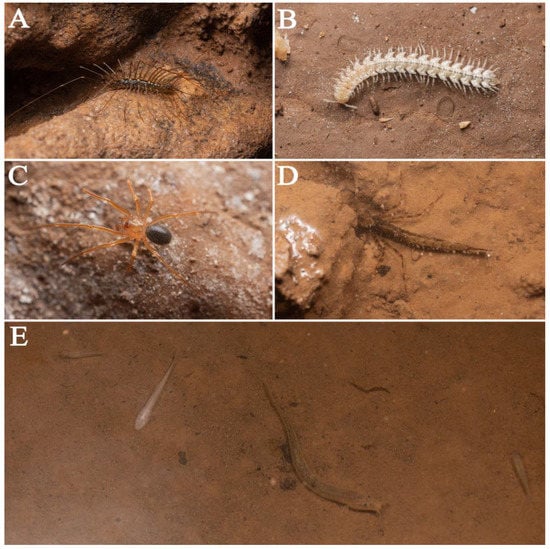
Figure 20.
Animals found in Tujiamei Dong: (A) Thereuopoda clunifera (Wood, 1862); (B) Epanerchodus tujiaphilus Liu and Golovatch, 2018; (C) Nesticella huomachongensis Lin, Ballarin and Li, 2016; (D) Synlestidae sp.; (E) shrimps Caridina longshan Cai and Ng, 2018, blind fish Triplophysa xiangxiensis (Yang, Yuan and Liao, 1986); and mud fish Cobitidae sp.
Moreover, further caves, Da Dong, Panlong Dong (Pa Long Dong), and Mao Dong, might also potentially be connected to Feihu Dong (Figure 1), as well as three potential shafts (Wang Y., pers. comm.) that may act as sources of food through the dripping or sinking waters (Figure 3). The three shafts are positioned above the cave system of Feihu Dong, but their connection with Feihu Dong would require further exploration. Numerous other caves that exist around Huoyan (in Longshan, Rongshun, and Sangzhi regions) have been less intensively, or not at all surveyed biologically. The rare available records that have been published indicate that they probably possess levels of species richness similar to those of Feihu Dong.
Although we know the significance of water for cave fauna, our understanding of the hydrogeology of Feihu Dong is still limited. No validated surface streams were addressed, except for the shaft ‘Gouffre Super Tong’ and three potential shafts (Figure 1) that may act as inlets for rainwater during the rainy season. The relationship between the cave’s water system and the external water system is not well understood and requires further research.
In conclusion, the study of Feihu Dong has exceeded expectations in terms of species richness, and it is likely that many other caves in China have a similar level of subterranean biodiversity. A further significant increase in species richness in South China’s caves and karsts can be expected in the near future. Even if research on cave fauna in China still lags behind that of some western countries [58,59,60], the results obtained on Feihu Dong are demonstrating the potential for South China to become a world hotspot for cave biodiversity. This is indeed stimulating for further investigations, even if there is still a long way to go to fully uncover the diversity of cave fauna in the huge karsts of South China. It is demanding to expand the scope and intensity of cave fauna surveys, and to explore and document the intricate subterranean habitats of caves and karsts in China through collaborative work.
Author Contributions
Conceptualization, M.T., W.L. and S.H.; methodology, S.H., M.Z. and W.L.; software, S.H., M.Z. and W.L.; validation, M.T., A.B., X.L., Y.W., M.C. and W.L.; formal analysis, S.H., M.Z. and W.L.; investigation, S.H., M.Z., A.B., M.C. and Y.W.; resources, Y.W., M.C., A.B. and S.H.; data curation, S.H. and M.Z.; writing—original draft preparation, S.H., M.Z., X.L. and W.L.; writing—review and editing, S.H., M.Z., A.B., M.T., X.L., M.C. and W.L.; visualization, S.H. and M.Z.; supervision, M.T. and W.L.; project administration, M.T. and W.L.; funding acquisition, M.T. and W.L. All authors have read and agreed to the published version of the manuscript.
Funding
This research received no external funding.
Institutional Review Board Statement
Not applicable.
Data Availability Statement
Not applicable.
Acknowledgments
We would like to express our sincere gratitude to various organizations, individuals, and teams who have contributed to the success of our research project on the subterranean biodiversity of Feihu Dong. We extend our appreciation to the Speleology Geological Professional Committee of the Geological Society of China, Xiangxi UNESCO Geopark, Wulongshan National Geopark, and Wulongshan Canyon Scenic Area for their support and cooperation throughout the project. We would also like to thank Yuanhai Zhang of the Institute of Karst Geology, Chinese Academy of Geological Sciences, for arranging the biocaving in Feihu Dong, which was instrumental in our research efforts. Special thanks go to Louis Deharveng from the Muséum National d’Histoire Naturelle for his efforts to inform the foundation about the biodiversity in Feihu Dong, Jian Zhou (member of the team Xiangxi Cave Expedition) for sharing valuable information and data about Feihu Dong, and Zhi Qian of the Guizhou Speleology Association for providing information about Shuanghe Dong. We are also grateful to the following individuals who assisted us in identifying various species in Feihu Dong: Jiajun Zhou of Zhejiang Forest Survey, Planning and Design Company and Xingliang Wang of Guizhou Normal University and for their expertise in identifying bats; Qidi Zhu of Hebei University for her help with crickets; Ziwei Yin of Shanghai Normal University for his assistance with Staphylinidae; Jisheng Wang of Dali University for his expertise in Siphonaptera; Yejie Lin of the Institute of Zoology, Chinese Academy of Sciences for identifying spiders; Feng Lu of Shenzhen University for his help with Harvestmen; and Hengjie Huang of South China Agricultural University for assisting with Scutigeridae. Additionally, we thank Lu Qiu of Mianyang Normal University for his help with mollusks. We would like to express our sincere gratitude to the three anonymous reviewers for their valuable feedback and suggestions, which have helped us to improve the quality of our work. We would also like to thank Georgi Angelov Geshev (Imperial College London, United Kingdom) and Sergei I. Golovatch (Russian Academy of Sciences, Moscow, Russia) for their assistance in checking and validating the English of our manuscript. Finally, we extend our thanks to other people from the South China Agricultural University Biocaving Team (Haomin Yin, Xinhui Wang, Mingruo Tang, Zijun Ma, Xinyang Jia, Yi Zhao) and the team Xiangxi Cave Expedition (烧鸟, 天悟, 末路, 三皮, 华华, 小爱, 虫子, 三二, 马儿, 笑笑, 水瓶, 畅畅, 鸡腿, 伙头军, 燕子, 不二, 余老师, 小郭耳朵, 浆糊, 烧成灰) for their assistance with caving and fieldwork in Feihu Dong. Thanks also to the Speleo-Club de Paris (France) for the support of the biological team during the 1995 speleological expedition, and to the SHAG Caving Association of Besançon (France) for the final cave topographies, conducted after the 1997 speleological expedition, with the support of the authorities from Hunan (the Institute of Geology of Hunan Province and the Government of Longshan County).
Conflicts of Interest
The authors declare no conflict of interest.
References
- Che, Y.T.; Yu, J.Z. Karst of China; Science Press: Beijing, China, 1985; pp. 1–230. [Google Scholar]
- Chen, W.H. An outline of speleology research progress. Geol. Rev. 2006, 52, 783–792. [Google Scholar]
- Song, X.; Gao, Y.; Green, S.M.; Dungait, J.A.J.; Peng, T.; Quine, T.A.; Xiong, B.; Wen, X.; He, N. Nitrogen loss from karst area in China in recent 50 years: An in-situ simulated rainfall experiment’s assessment. Ecol. Evol. 2017, 7, 10131–10142. [Google Scholar] [CrossRef] [PubMed]
- Xiong, K.N. Karst and World Natural Heritage in Southern China. In Proceedings of the Southwest Region Conference of Mountain Environment and Ecological Civilization Construction of the Chinese Geographical Society Annual Academic Conference, Kunming, Yunnan, 27 April 2013. [Google Scholar]
- Williams, P.W. Karst in UNESCO World Heritage Sites. In Karst Management; van Beynen, P.E., Ed.; Springer: Dordrecht, The Netherlands, 2011; pp. 459–480. ISBN 978-94-007-1206-5/978-94-007-1207-2. [Google Scholar] [CrossRef]
- Latella, L. Biodiversity: China. In Encyclopedia of Caves; Elsevier: Amsterdam, The Netherlands, 2019; pp. 127–135. ISBN 978-0-12-814124-3. [Google Scholar] [CrossRef]
- Luo, S.W.; He, W.; Zhang, Y.H.; Deng, Y.D.; Wu, K.H.; Zhou, W.L.; Zhang, H.Z.; Luo, S.Q. Influence of Shuanghe Cave development on the changes of surface water system in Suiyang County, Guizhou, China. Carsologica Sin. 2021, 40, 920–931. [Google Scholar] [CrossRef]
- Zhou, Y.J. Exploring the underground world: World’s largest cave chamer by volume–Ziyun Miao Room Chamber. New Era Ecol. Civiliz. 2018, 2, 41–46. [Google Scholar]
- Wang, X.Y. Longest karstic caves in China. Carsologica Sin. 1988, 7, 384. [Google Scholar]
- Zhu, X.W.; Chen, W. Tiankengs in the karst of China. Speleogenesis Evol. Karst Aquifers 2006, 4, 1–18. [Google Scholar]
- Liu, W.; Wynne, J.J. Cave millipede diversity with the description of six new species from Guangxi, China. Subterr. Biol. 2019, 30, 57–94. [Google Scholar] [CrossRef]
- Zhu, Q.; Chen, H.; Shi, F. Remarks on the genus Tachycines Adelung, 1902 (Orthoptera: Rhaphidophoridae: Aemodogryllinae) with description of eight new species from caves in southern China. Zootaxa 2020, 4809, 71–94. [Google Scholar] [CrossRef]
- Zhu, W.; Yao, Z.; Zheng, G.; Li, S. Six new species of the spider genus Belisana Thorell, 1898 (Araneae: Pholcidae) from southern China. Zootaxa 2020, 4810, 175–197. [Google Scholar] [CrossRef]
- Zhao, Y.; Guo, W.-R.; Golovatch, S.I.; Liu, W.-X. Revision of the javanicus species group of the millipede genus Glyphiulus Gervais, 1847, with descriptions of five new species from China (Diplopoda, Spirostreptida, Cambalopsidae). ZooKeys 2022, 1108, 89–118. [Google Scholar] [CrossRef]
- Zhou, X.; Yang, W. Ten new species of genus Tachycines (Orthoptera, Rhaphidophoridae, Aemodogryllinae) from karst caves in Guizhou, China. ZooKeys 2022, 1109, 115–140. [Google Scholar] [CrossRef]
- Tian, M.Y.; Huang, S.B.; Jia, X.Y. A contribution to cavernicolous beetle diversity of South China Karst: Eight new genera and fourteen new species (Coleoptera: Carabidae: Trechini). Zootaxa 2023, 5243, 1–66. [Google Scholar] [CrossRef]
- Hou, Y.; Feng, Z.; Zhang, F. Diversity of cave-dwelling pseudoscorpions from Guizhou in China, with the description of twenty-four new species of the genus Tyrannochthonius (Pseudoscorpiones, Chthoniidae). Zootaxa 2023, 5062, 1–158. [Google Scholar] [CrossRef]
- Huang, S.B.; Wei, G.F.; Wang, H.S.; Liu, W.X.; Bedos, A.; Deharveng, L.; Tian, M.Y. Ganxiao Dong: A hotspot of cave biodiversity in northern Guangxi, China. Diversity 2021, 13, 355. [Google Scholar] [CrossRef]
- Tian, M.Y.; Liu, W.X.; Huang, S.B.; Luo, X.Z. Biospeleology; Geological Publishing House: Beijing, China, 2023; pp. 1–248. [Google Scholar]
- Li, M.Q. Afforestation design for Wulong Mountain Sights. J. Nanjing Agric. Technol. Coll. 1999, 15, 52–54. [Google Scholar]
- Deuve, T. Descriptions de trois Trechinae anophtalmes cavernicoles dans un karst du Hunan, Chine (Coleoptera, Trechidae). Rev. Française D’entomologie N.S. 1996, 18, 41–48. [Google Scholar]
- Xiangxi 95, Expédition Franco-Chinoise, Report; Delprat, B., Ed.; La Salamandre: La Ciotat, France, 1998. [Google Scholar]
- Uéno, S.I. New genera and species of aphaenopsoid trechines (Coleoptera, Trechinae) from South-Central China. Elytra 1999, 27, 617–633. [Google Scholar]
- Yao, Y.R. Genetic Diversity and Physiology of the Cavefish Triplophysa xiangxiensis. Ph.D Dissertation, Huazhong Agricultural University, Wuhan, China, 2012. [Google Scholar]
- Deharveng, L.; Bedos, A. La faune des grottes de Huoyan. In Xiangxi 95, Expédition Franco-Chinoise, Report; Delprat, B., Ed.; La Salamandre: La Ciotat, France, 1998; pp. 183–185. [Google Scholar]
- Deharveng, L.; Bedos, A. The cave fauna of southeast Asia. Origin, evolution and ecology. In Ecosystems of the World Vol 30 Subterranean Ecosystems; Wilkens, H., Culver, D.C., Humphreys, W.F., Eds.; Elsevier: Amsterdam, The Netherlands, 2000. [Google Scholar]
- Deharveng, L.; Bedos, A. Diversity patterns in the tropics. In Encyclopedia of Caves; Elsevier: Amsterdam, The Netherlands, 2012; pp. 238–250. [Google Scholar]
- Yang, G.R.; Yuan, F.X.; Liao, R.M. A new blind Cobitidae fish from the subteranean water in Xiangxi, China. J. Huazhong Agric. Univ. 1986, 5, 219–223. [Google Scholar]
- Cai, Y.; Ng, P.K.L. Freshwater Shrimps from Karst Caves of Southern China, with Descriptions of Seven New Species and the Identity of Typhlocaridina linyunensis Li and Luo, 2001 (Crustacea: Decapoda: Caridea). Zool. Stud. 2018, 57, e27. [Google Scholar]
- Jochum, A.; Slapnik, R.; Kampschulte, M.; Martels, G.; Heneka, M.; Pall-Gergely, B. A review of the microgastropod genus Systenostoma Bavay & Dautzenberg, 1908 and a new subterranean species from China (Gastropoda, Pulmonata, Hypselostomatidae). ZooKeys 2014, 410, 23–40. [Google Scholar] [CrossRef]
- Zhao, Z.; Li, S. Papiliocoelotes gen. N., a new genus of Coelotinae (Araneae, Agelenidae) spiders from the Wuling Mountains, China. ZooKeys 2016, 585, 33–50. [Google Scholar] [CrossRef][Green Version]
- Golovatch, S.I.; Geoffroy, J.-J.; Mauries, J.-P.; Van Den Spiegel, D. Review of the millipede genus Glyphiulus Gervais, 1847, with descriptions of new species from Southeast Asia (Diplopoda, Spirostreptida, Cambalopsidae). Part 1: The granulatus-group. Zoosystema 2007, 29, 7–49. [Google Scholar]
- Golovatch, S.I. Cave Diplopoda of southern China with reference to millipede diversity in Southeast Asia. ZooKeys 2015, 510, 79–94. [Google Scholar] [CrossRef]
- Smetana, A. Contributions to the knowledge of the Quediina (Coleoptera, Staphylinidae, Staphylinini) of China. Part 15. Genus Strouhalium Scheerpeltz, 1962. Section 3. Genus Quedius Stephens, 1829. Subgenus Microsaurus Dejean, 1833. Section 9. Elytra 1999, 27, 519–534. [Google Scholar]
- Gorochov, A.V.; Rampini, M.; Di Russo, C. New species of the genus Diestrammena (Orthoptera: Rhaphidophoridae: Aemodogryllinae) from caves of China. Russ. Entomol. J. 2006, 15, 355–360. [Google Scholar]
- Zhu, Q.D.; Shi, F.M. Description of four new species of the subgenus Tachycines (Gymnaeta) Adelung, 1902 (Orthoptera: Rhaphidophoridae) from caves in China and additional notes on some previously known species. Eur. J. Taxon. 2021, 764, 1–17. [Google Scholar] [CrossRef]
- Fu, D.F.; Zhang, Y.X.; Jiang, X.; Liu, Z.X.; Yan, Z.J.; Yang, W.W.; Zeng, W.X. Distribution Record of Myotis altarium Thomas in Hunan Province of China. J. Jishou Univ. Nat. Sci. Ed. 2010, 31, 106–108. [Google Scholar]
- Lu, F.; Wang, L.Y.; Zhang, C. Schenkeliobunum wuxi sp. nov., a new harvestmen species from Chongqing, China (Opiliones: Sclerosomatidae). Acta Arachnol. Sin. 2022, 31, 75–80. [Google Scholar]
- Golovatch, S.I.; Geoffroy, J.-J.; Mauriès, J.-P.; Van Den Spiegel, D. Review of the millipede genus Eutrichodesmus Silvestri, 1910, in China, with descriptions of new cavernicolous species (Diplopoda, Polydesmida, Haplodesmidae). ZooKeys 2015, 505, 1–34. [Google Scholar] [CrossRef]
- Li, Q.; Pei, S.; Guo, X.; Ma, H.; Chen, H. Australobius Tracheoperspicuus sp. N., the first subterranean species of centipede from southern China (Lithobiomorpha, Lithobiidae). ZooKeys 2018, 795, 83–91. [Google Scholar] [CrossRef]
- Sendra, A.; Komerički, A.; Lips, J.; Luan, Y.; Selfa, J.; Jiménez-Valverde, A. Asian cave-adapted diplurans, with the description of two new genera and four new species (Arthropoda, Hexapoda, Entognatha). Eur. J. Taxon. 2021, 731, 1–46. [Google Scholar] [CrossRef]
- Yin, Z.-W.; Li, L.-Z. Zopherobatrus gen. n. (Coleoptera: Staphylinidae: Pselaphinae), a new troglobitic batrisine from southwestern China. Zootaxa 2015, 3985, 291. [Google Scholar] [CrossRef] [PubMed]
- Ma, L.; Zhao, Y.; Yang, J. Cavefish of China. In Encyclopedia of Caves; Elsevier: Amsterdam, The Netherlands, 2019; pp. 237–254. ISBN 978-0-12-814124-3. [Google Scholar] [CrossRef]
- Lu, Z.-M.; Li, X.-J.; Lü, W.-J.; Huang, J.-Q.; Xu, T.-K.; Huang, G.; Qian, F.-Q.; Yang, P.; Chen, S.-G.; Mao, W.-N.; et al. Triplophysa xuanweiensis sp. Nov., a new blind loach species from a cave in China (Teleostei: Cypriniformes: Nemacheilidae). Zool. Res. 2022, 43, 221–224. [Google Scholar] [CrossRef] [PubMed]
- Liu, F.; Zeng, Z.-X.; Gong, Z. Two new hypogean species of Triplophysa (Cypriniformes: Nemacheilidae) from the River Yangtze drainage in Guizhou, China. J. Vertebr. Biol. 2022, 71, 22062.1–22062.14. [Google Scholar] [CrossRef]
- Xu, D.-J.; Li, D.-X.; Zheng, X.-Z.; Guo, Z.-L. Caridina sinanensis, a new species of stygobiotic atyid shrimp (Decapoda, Caridea, Atyidae) from a karst cave in the Guizhou Province, southwestern China. ZooKeys 2020, 1008, 17–35. [Google Scholar] [CrossRef]
- Guo, G.-C.; Chen, Q.-H.; Chen, W.-J.; Cai, C.-H.; Guo, Z.-L. Caridina stellata, a new species of atyid shrimp (Decapoda, Caridea, Atyidae) with the male description of Caridina cavernicola Liang & Zhou, 1993 from Guangxi, China. ZooKeys 2022, 1104, 177–201. [Google Scholar] [CrossRef]
- Hou, Z.; Zhao, S.; Li, S. Seven new freshwater species of Gammarus from southern China (Crustacea, Amphipoda, Gammaridae). ZooKeys 2018, 749, 1–79. [Google Scholar] [CrossRef]
- Taiti, S.; Xue, Z. The cavernicolous genus Trogloniscus nomen novum, with descriptions of four new species from southern China (Crustacea, Oniscidea, Styloniscidae). Trop. Zool. 2012, 25, 183–209. [Google Scholar] [CrossRef]
- Kottelat, M. The IUCN Red List of Threatened Species 1996: E.T22202A9364418. In Triplophysa xiangxensis; IUCN: Gland, Switzerland, 1996. [Google Scholar] [CrossRef]
- Zhao, Y.; Zhang, Y.Y.; Zhao, Y.H. Assessment of endangerment category on Chinese cavefish: A case study of two national protected fish species. Carsologica Sin. 2021, 40, 1032–1037. [Google Scholar]
- Deharveng, L.; Huang, S.; Tian, M. The IUCN Red List of Threatened Species 2020: E.T120544161A120547523. In Huoyanodytes tujiaphilus; IUCN: Gland, Switzerland, 2019. [Google Scholar] [CrossRef]
- Deharveng, L.; Huang, S.; Tian, M. The IUCN Red List of Threatened Species 2020: E.T120504866A120504946. In Cathaiaphaenops delprati; IUCN: Gland, Switzerland, 2019. [Google Scholar] [CrossRef]
- Viana, A.C.M.; Ferreira, R.L. A new troglobitic species of Allochthonius (subgenus Urochthonius) (Pseudoscorpiones, Pseudotyrannochthoniidae) from Japan. Subterr. Biol. 2021, 37, 43–55. [Google Scholar] [CrossRef]
- Brunke, A.J.; Hansen, A.K.; Salnitska, M.; Kypke, J.L.; Predeus, A.V.; Escalona, H.; Chapados, J.T.; Eyres, J.; Richter, R.; Smetana, A.; et al. The limits of Quediini at last (Staphylinidae: Staphylininae): A rove beetle mega-radiation resolved by comprehensive sampling and anchored phylogenomics. Syst. Entomol. 2021, 46, 396–421. [Google Scholar] [CrossRef]
- Tian, M.Y.; Huang, S.B.; Wang, X.H.; Tang, M.R. Contributions to the knowledge of subterranean trechine beetles in southern China’s karsts: Five new genera (Insecta, Coleoptera, Carabidae, Trechinae). ZooKeys 2016, 564, 121–156. [Google Scholar] [CrossRef]
- Liu, W.; Golovatch, S. The millipede genus Epanerchodus Attems, 1901 in continental China, with descriptions of seven new cavernicolous species (Diplopoda, Polydesmida, Polydesmidae). Zootaxa 2018, 4459, 053–084. [Google Scholar] [CrossRef]
- Zagmajster, M.; Polak, S.; Fišer, C. Postojna-Planina Cave System in Slovenia, a Hotspot of Subterranean Biodiversity and a Cradle of Speleobiology. Diversity 2021, 13, 271. [Google Scholar] [CrossRef]
- Polak, S.; Pipan, T. The Subterranean Fauna of Križna Jama, Slovenia. Diversity 2021, 13, 210. [Google Scholar] [CrossRef]
- Iliffe, T.M.; Calderón-Gutiérrez, F. Bermuda’s Walsingham Caves: A global hotspot for anchialine stygobionts. Diversity 2021, 13, 352. [Google Scholar] [CrossRef]
Disclaimer/Publisher’s Note: The statements, opinions and data contained in all publications are solely those of the individual author(s) and contributor(s) and not of MDPI and/or the editor(s). MDPI and/or the editor(s) disclaim responsibility for any injury to people or property resulting from any ideas, methods, instructions or products referred to in the content. |
© 2023 by the authors. Licensee MDPI, Basel, Switzerland. This article is an open access article distributed under the terms and conditions of the Creative Commons Attribution (CC BY) license (https://creativecommons.org/licenses/by/4.0/).